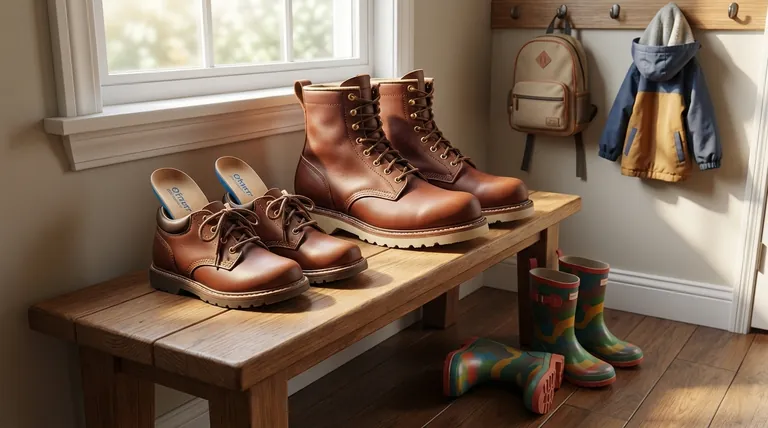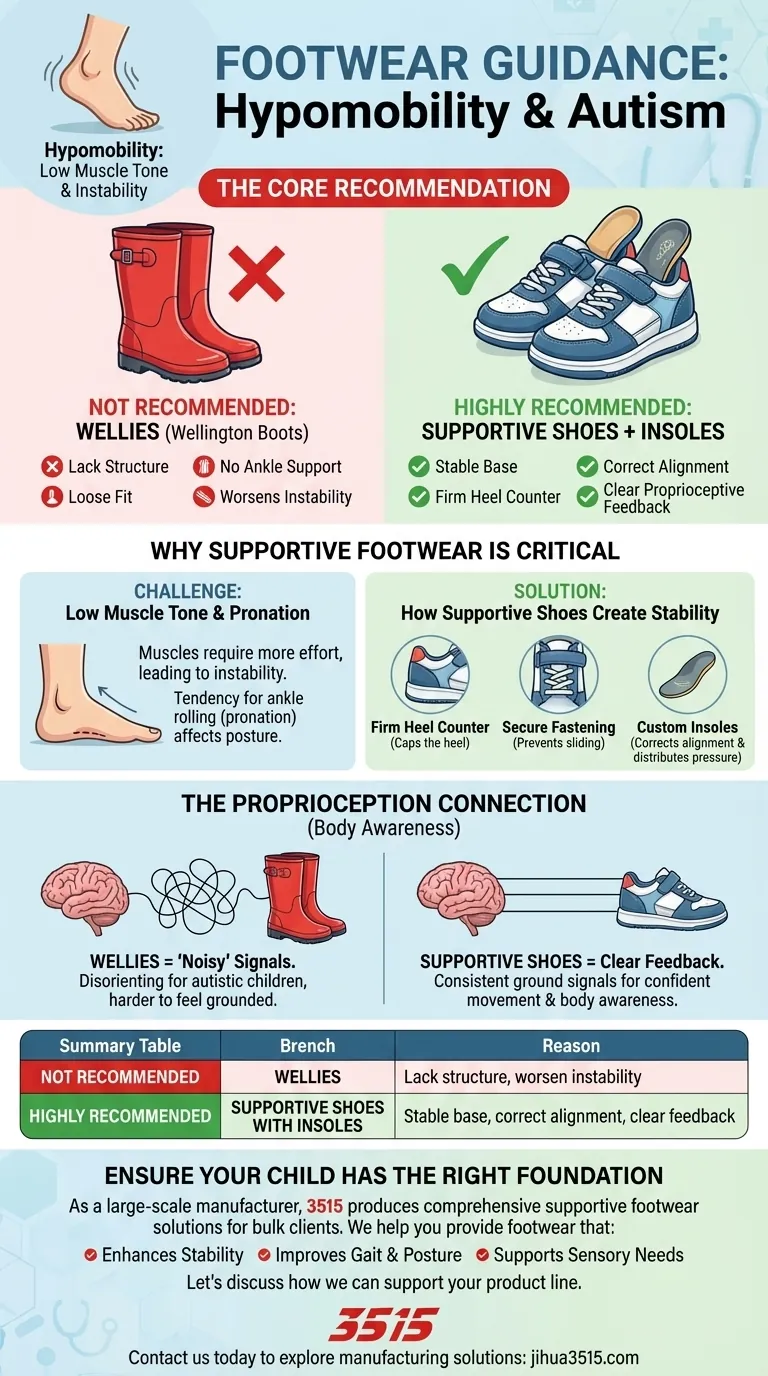Based on the physiotherapist's advice, the specific type of footwear recommended against for a child with hypomobility and autism was wellies (wellington boots). The guidance emphasized the need for the child to consistently wear supportive shoes equipped with insoles instead.
The core issue extends beyond a single type of boot. For a child with low muscle tone, the fundamental goal is to provide consistent external support to the foot and ankle, a function that unstructured footwear like wellies simply cannot fulfill.

Why Supportive Footwear is Critical
A diagnosis of hypomobility, often characterized by low muscle tone, means a child's joints may be overly flexible and less stable. This places a greater demand on footwear to provide the structural support that muscles and ligaments would normally offer.
The Challenge of Low Muscle Tone
Low muscle tone means muscles are lax and require more effort to contract. This can lead to instability, particularly in the feet and ankles, which form the body's foundation.
Children with hypomobility often have a tendency for their ankles to roll inward and their feet to appear flat. This condition, known as pronation or pes planus, can affect their entire posture and gait.
How Supportive Shoes Create Stability
A truly supportive shoe acts as an external skeleton for the foot. It provides a firm and stable base that helps align the bones in the foot and ankle correctly.
Key features to look for include a firm heel counter (the back part of the shoe that cups the heel) and a fastening mechanism like laces or Velcro that secures the foot firmly in place. This prevents the foot from sliding and the ankle from rolling.
The Essential Role of Insoles
Insoles, or orthotics, are prescribed to provide customized support inside the shoe. They are designed to correct alignment issues, such as supporting the arch of the foot in cases of pronation.
By ensuring the foot is in its optimal position, insoles help distribute pressure evenly and improve the overall mechanics of walking and running.
The Problem with Unsupportive Footwear
The advice to avoid wellies is a specific example of a broader principle: any shoe that lacks structure is detrimental for a child who needs stability.
The Case Against Wellies
Wellies fail on every key requirement for supportive footwear. They are typically made of a single piece of flexible rubber with no structural components.
They offer no ankle support, have a loose fit, and lack a firm heel counter. This allows the foot to move excessively inside the boot, which can worsen instability and lead to an inefficient walking pattern.
Connecting Footwear to Proprioception
For many children with autism, processing sensory information can be a challenge. Proprioception is the body's ability to sense its own position in space.
Supportive, well-fitted shoes provide consistent and clear feedback from the ground to the brain. Unstable footwear like wellies creates "noisy," unpredictable sensory signals, which can be disorienting and make it harder for the child to feel grounded and confident in their movements.
Making the Right Choice for Your Child
The right footwear is not just a covering; it is a foundational tool that impacts a child's stability, confidence, and overall development.
- If your primary focus is daily stability and safety: Always opt for structured, supportive shoes with the prescribed insoles for all-day wear.
- If your primary focus is encouraging confident movement: Ensure that play shoes or athletic sneakers have a firm base and secure fastenings to prevent trips and support dynamic activity.
- If your primary focus is managing sensory and physical needs together: Prioritize a proper fit that is snug but not constricting, as this provides the clear proprioceptive feedback crucial for body awareness.
Choosing the right footwear is a simple yet powerful way to provide the foundation your child needs to move with greater safety and confidence.
Summary Table:
| Footwear Type | Recommendation | Key Reason |
|---|---|---|
| Wellies (Wellington Boots) | Not Recommended | Lack structure, ankle support, and a firm heel counter, worsening instability. |
| Supportive Shoes with Insoles | Highly Recommended | Provide a stable base, correct alignment, and clear proprioceptive feedback. |
Ensure Your Child Has the Right Foundation for Confident Movement
Choosing the correct footwear is crucial for a child's stability and development. As a large-scale manufacturer, 3515 produces a comprehensive range of supportive footwear for distributors, brand owners, and bulk clients. Our production capabilities encompass all types of children's shoes and boots designed with the necessary structural support, firm heel counters, and secure fastenings.
We can help you provide footwear that:
- Enhances Stability: Our shoes act as an external skeleton, providing the support low muscle tone demands.
- Improves Gait & Posture: Properly designed footwear helps correct alignment issues like pronation.
- Supports Sensory Needs: A secure, well-fitted shoe offers clear proprioceptive feedback, which is vital for children with autism.
Let's discuss how we can support your product line with high-quality, therapeutic footwear.
Contact us today to explore manufacturing solutions tailored to your needs.
Visual Guide

Related Products
- Wholesale Durable Leather Work Boots | 8-Inch Goodyear Welt Manufacturer
- Durable Military Combat Boots with Water Drainage for Wholesale & OEM
- Wholesale High-Traction Camo Boots - Custom Manufacturer for Brands
- Wholesale Classic Leather Lace-Up Ankle Boots for Brand Manufacturing
- Durable Mid-Cut Tactical Boots for Wholesale & Private Label
People Also Ask
- What are the advantages and disadvantages of leather as a shoe material? Unlock Durability, Comfort & Style
- What makes work boots durable? The 3 Key Factors for Long-Lasting Footwear
- How should new leather work boots be broken in? A Guide to Comfort and Durability
- Do heavy duty work boots stretch over time? The Truth About Fit & Break-In
- How can the flexibility of leather work boots be maximized? Achieve Lasting Comfort & Performance



















